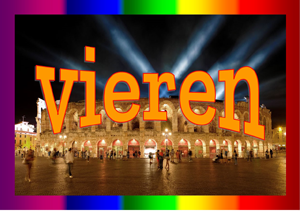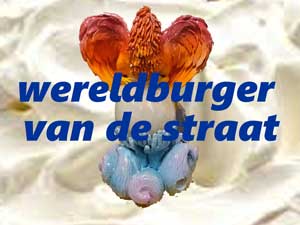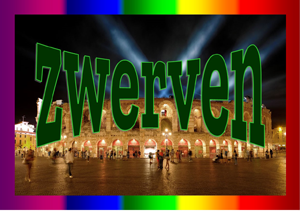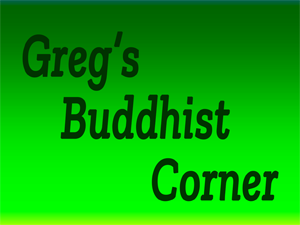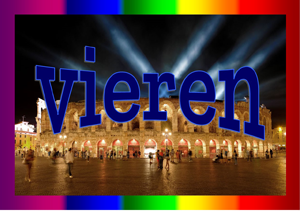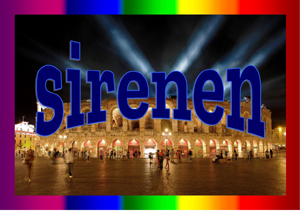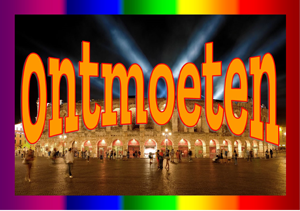Celebrating 40 Years of Tibetan Buddhism in Holland
By Greg Suffanti
QFWF October 2019
The Visiting Lamas of Maitreya Instituut
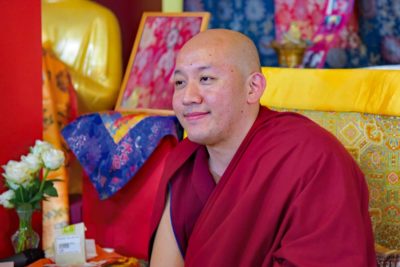
In addition to visiting Lamas like Lama Zopa Rinpoche, H.E. Zong Rinpoche, H.E. Ling Rinpoche, Geshe Lhudrup Sopa and Yangsi Rinpoche, Maitreya Instituut also has two lamas who teach regularly at the two centers while living outside of the Netherlands: Geshe Sonam Ngodrup and Geshe Yeshe Rinchen.
Geshe Sonam Ngodrup first came to Maitreya Instituut from Nalanda Monastery in 2012, along with his very personable, loyal and capable translator, Ven. Khedrup. Geshe Ngodrup was born in 1968, in Kham, Tibet. After escaping Tibet, he went to Sera Je Monastery in S. India, where his uncle was also living as a monk. His uncle is Khen Rinpoche Geshe Lobsang Delek, the recently retired Abbott of Sera Je Monastery. Khen Rinpoche once told me that Geshe Ngodrup was always a very good student and studied very hard when he was a student, which helps explain why he not only earned the Lharampa Geshe degree, but was selected as one of the three best students at Sera, Ganden and Drepung monasteries, the ‘big three’ of the Tibetan Buddhist universities. When later teaching at Sera Je, he became one of the monastery’s most popular teachers, as he is a combination of gentleness, humor and stunning intellect.
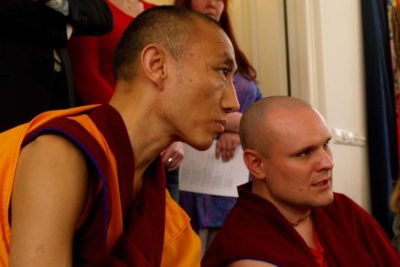
Personally, it has been Geshe Ngodrup’s great compassion that has moved me the most. Although I am truly impressed by his vast knowledge, it is his great love, respect and kindness for all others that has left the deepest impression on me and captured my heart. I’ve had many teachings and initiations from Geshe la, and he and Khedrup (as he prefers being called) have been frequent guests in my home. I consider them both very special friends. Lama Zopa Rinpoche says deciding who your main teacher is, your ‘root guru’, is easy; “it’s the teacher who’s had the most impact on your mind.” For me, this is Geshe Ngodrup. My favorite personal story about Geshe Ngodrup is Christmas 2015, when he and Khedrup traveled from Loenen to spend the day with me as I was alone on the holiday. After about an hour of small talk, Geshe la got bored and started watching a teaching from His Holiness the Dalai Lama on his iPad. Khedrup and I simply moved to the kitchen to continue cooking the holiday dinner and our usual endless conversations and everyone was happy.
He has taught in Germany, Italy, France, Switzerland, Denmark, the Netherlands, and has recently been invited to become the resident teacher at an FPMT center in Toronto, Canada. He and translator Ven. Khedrup, who travels with Geshe Ngodrup, have a spontaneous, sincere and warm relationship, and their ease and humor with each-other make for a delightful combination, which is undoubtably why he is in such high demand. Geshe Ngodrup teaches regularly at Maitreya Instituut, as his schedule allows.
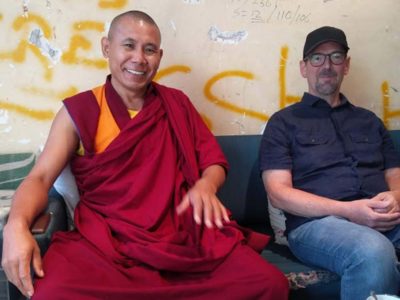
Geshe Yeshe Rinchen was born in 1968 in Lhasa, Tibet. Although he attended school between the ages of six and ten, he was forced to stop in order to work the fields to help support his impoverished family. He was ordained at sixteen and left Tibet in 1990, on foot, walking for five weeks to Nepal, following a route close to Mt. Everest. He also studied at Sera Je Monastery, and earned his Lharampa Geshe degree in 2010. Geshe Rinchen started teaching at Maitreya Instituut in Amsterdam in 2017, per the request of Lama Zopa Rinpoche, and he comes about six times per year to give Dharma weekends in Amsterdam. Starting in 2020, Geshe Rinchen will teach at both of Maitreya Instituut’s locations. He is a learned and down-to-earth teacher, with a keen sense of humor and a very open approach, that allows everyone to feel at ease and to actively participate. He’s trying to cover some of the basics of Buddhism, and will be teaching in the coming months on the sutra path to enlightenment called the ‘sa lam’. Since coming to Amsterdam to teach, he’s been a frequent guest in my home, including several occasions when I’ve been out of the country. What a delightful surprise to return to a house that is even cleaner than when I left, and what a joy to be there when Geshe Rinchen is actually there, because he’s an incredible cook as well. My favorite personal story about Geshe Rinchen is from January of this year when we were standing and waiting to eat at a very busy Chinese restaurant, filled with Chinese diners and Chinese personnel; Geshe Rinchen stood there the entire twenty minutes wearing his “Free Tibet” cap and a broad smile. Geshe Rinchen also teaches regularly in France and Spain.
Other teachers and talents regularly scheduled at Maitreya Instituut include:
Alan Wallace, Ven. Jan Bijman, Ven. Jampa Ludrup, Janny de Boer & Alex de Haan, Carmen Mensinck/ thangka painting, Ven. Robina Courtin, Ven. Sangye Khadro, Andy Weber, Annelies van der Heijden, Feng Shui lessons and more.
Please visit www.maitreya.nl for more detailed information.
Bright Lights, Big City: Ven. Losang Gendun
Amsterdam’s new resident teacher, Ven. Losang Gendun, goes from being a forest-monk in Myanmar to leading Buddhist ‘Boot Camps’ at the center’s Amsterdam location. He’s not your typical monk …
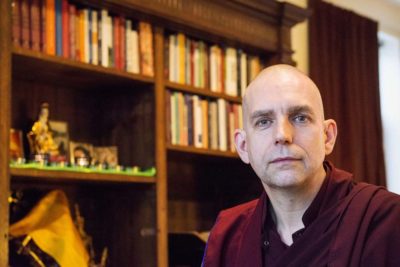
In 2017, Ven. Losang Gendun finished a three-year retreat, including a year in the forests of Myanmar, and accepted the FPMT’s invitation to become Maitreya Institute’s resident teacher in Amsterdam. The FPMT is a worldwide network of more than 150 centers, headed by Lama Zopa Rinpoche. Ven. Gendun had previously taught in Europe and America. He replaced Ven. Kaye Miner, who’d been both resident teacher in Amsterdam and center director in Emst, and had to resign in 2017 due to chronic illness.
A Burgundian beginning… and a ‘new vision of the unity of existence’
Ven. Losang Gendun grew up in the South of the Netherlands, which is predominantly Catholic, as Michel Sengers. He says of this time, that “religion and society were of a so called ‘Burgundian’ type, with a strong sense of joie-de-vivre, and all overseen by a gentle and forgiving father-deity.” “Biblical stories related at church and at the dinner table provided not only a backdrop to my individual life, but also gave meaning and coherence.” However, there were questions as well, including “questioning this identarian and self-righteous sense of religion itself.”
Ven. Gendun’s grandfather was an amateur theologist who had helped a Trappist monk relocate from East Germany to a monastery called ‘de Achelse Kluis’ in Belgium. This brought the young Michel into regular contact with Brother Amadeus and the monastery itself. A chance encounter with one of the monastery’s monks had a lasting impression on Michel. Ven. Gendun now recalls, “it was a gorgeous spring morning, and this monk showed me a new vision of the unity of existence. It took me nearly thirty years to digest,” and ultimately, “led me on my own path to monasticism.”
After hearing the Dharma for the first time, I knew I’d arrived home
Life, however, had other plans for Michel. The path to the monastery was not a direct one, and Michel reflects that his “turbulent adolescence ended in a foster family, while struggling with drug and alcohol abuse.” A friend suggested he try meditation, and so he consulted the Yellow Pages and found a Buddhist temple in Waalwijk. Once there, he met a monk who “displayed the same equanimous, gentle demeanor that I had encountered in the Achelse Kluis so many years before.” “Here again was this sense of wholeness in the other that somehow held and comforted my own fractured self.” However, “it was hearing the Dharma for the first time though, that I really knew I’d arrived home.”
Buddhism allowed me to be a participant in the sacred and the divine
“Here was a spirituality that was not exclusive or normative, but one that invited (the participant) to explore its truths through logic and contemplative experimentation. I felt empowered by the fact that here was a spirituality in which I was a participant, thus turning my life into something sacred rather than sinful and separated from the divine.”
That recurring dream led me in the certainty that I wanted to get ordained
“By chance I encountered the Tibetan Buddhist monastery of Nalanda in the South of France, and I engaged in a year-long retreat. It was during this period that the young Michel “had recurrent and lucid dreams” about that encounter with the monk at the Achelse Kluis all those years earlier. These experiences resulted “in the certainty that I wanted to get ordained.” Two weeks later he was ordained by the current Ganden Tripa (the lineage holder of the Gelug school) and as he puts it, the experience has been “a feast of exuberance and freedom which I have enjoyed ever since.” Ven. Gendun received full ordination three years later, in 2006, from His Holiness the Dalai Lama in Dharamsala, India.
Ven. Gendun also works with the Sufi teacher Nur Arturan to link different traditions together
After almost a decade of study and retreat, Ven. Gendun found himself teaching more and more as he is not only passionate and articulate about Buddhism, he is fluent in English, French and Dutch. Ven. Gendun is also passionate about interreligious dialogue and spiritual cooperation. It is through his own efforts and curiosity that he’s formed a meaningful bond with the Sufi community of Toulouse, France. His lasting friendship with the Turkish teacher Nur Arturan, has resulted in collaborative efforts, including a recent symposium at both of Maitreya Instituut’s locations.
“In 2015 I decided to go into retreat once again. This time for three years: initially on Nalanda’s grounds, for a year as a forest monk at Pa Auk monastery in Myanmar, and finally at my friend Nur’s Derga in Istanbul. After the retreat I accepted the appointment as resident teacher in Amsterdam.”
“I think Buddhism is experiencing something of a coming of age” Ven. Gendun
Ven. Gendun thinks Buddhism is “experiencing something akin to a coming of age; often either adolescently dogmatic and cultish,” or, “materialistic,” often disregarding “history, tradition and content.”
This may sound a bit negative, however, Ven. Gendun is convinced we can “make use of our own cultural strengths.”
“In the courses I teach at the center I try to evoke the pragmatic and open-ended approach of the scientific method, so that students are encouraged to move beyond the theory into the realms of personal experience. The Buddha challenged us not to believe in him, but to find out (the truth) for ourselves. Our humanist tradition should serve us well in taking the compassionate ideals of Buddhism and deploying them for the benefit of society around us.”
I want to use the example of the Buddha to be a force for good in our tumultuous times
“It should be our historic awareness of the millions that died in Europe because of religious strife, bigotry, colonialism and racism, and then to use the Buddha’s example of inclusivity, dialogue and loving-kindness towards all beings in order to be a force for the good in our tumultuous times.”
Maarten de Vries, Man About Town:
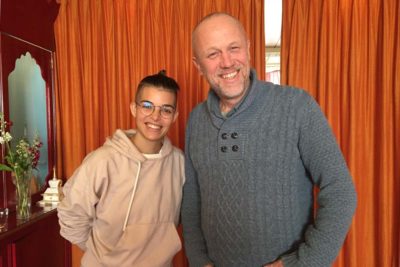
Professional chef, turned Buddhist, turned Buddhist chef, turned director of Maitreya Instituut Loenen, turned assistant director, looks back at his Buddhist life, and the new center he helped find, moving from an old and decrepit youth hostel to a large hotel and meeting facility … he’s ‘retired’ now and is happily assistant director of Loenen …
In the early morning hours, I had an experience that changed my life forever
Summer 2002:
“Suddenly, in the middle of the night, it hit me! I was reading alone in my apartment. I was single again, so there was time for things I had long neglected, like reading. A week earlier I had come home from the bookstore with a big pile of books that turned out to be great classics of Buddhist literature. I had always liked Buddhism, but didn’t know much about it. That night, I was fascinated by the world of Buddhist philosophy, and I felt like I was coming home.”
“In the early morning hours, I had an experience that would change my life forever. Up until then, I was a Chef and had worked in many renowned restaurants and hotels. I had just started working for a restaurant in Amsterdam. The owner was a good friend, and we started getting dream reviews. We made a great team.”
I felt what it was like to die that way … My career was over
“I began thinking about our menu, showcasing many of my own creations. Among the dishes was a crab bisque and grilled lobster. My shift was due to start at 2pm. It was now 2am. Out of nowhere, I began to vividly experience what it must be like to be boiled or sautéed alive. I felt what it was like to die that way. I sat there, stunned.”
“With trepidation, I knew I could never go back to the way things were. This was huge. My career was over.”
“Now what? I had gone from ‘Foie Gras’ enthusiast to vegetarian overnight. I couldn’t even look at the meat section of the supermarket anymore. How was this possible?”
“After a brief tour of local Buddhist centers, I got the opportunity to speak with Ven. Kaye Miner at Maitreya Instituut in Amsterdam. She told me about Lama Zopa Rinpoche and Kopan Monastery in Nepal. I then knew what my next step would be.”
My friends and family thought I had lost my mind
“My friends and family thought I had lost my mind. “You did what?” I took a job as a truck driver to pay for my trip to Nepal and started chanting ‘om mani padme hum’ in traffic jams. But I wasn’t done cooking yet.”
“After my second retreat at the monastery, Ven. Kaye asked me to help her out. She explained that Lama Zopa was coming to the Netherlands and they needed someone to cook for the 120+ attendees. The center was located in Emst then, and after that summer I decided to stay. Before that time, I’d never heard of the place.”
Geshe Sonam Gyaltsen became closer to my heart every day
“I tried out vegetarian recipes on unsuspecting meditators. My next step was to become a monk. That never happened. Yet.”
“I cooked vegetarian meals for the courses in Emst for five years. Living at the center allowed me to immerse myself in the Buddhist teachings. Geshe Sonam Gyaltsen, the center’s resident teacher, became closer to my heart every day. The plan to ordain and join a monastery in France faded. While cooking, I would listen live to every teaching Geshe la gave. I sang along with the traditional prayers in Tibetan from behind the stove. The monastery had come to me, in a way.”
One day I received a call from Ven. Kaye, who said, ‘we need to talk’
“One day I received a phone call from Ven. Kaye, who was now both director of Emst, and resident teacher of the Amsterdam center. She sounded serious when she said, ‘we need to talk’. I must have done something terribly wrong, I thought. It turned out Lama Zopa had chosen my name as the next director of Maitreya Institute in Emst.”
“I didn’t like that idea at all. I never applied for the job. I didn’t even know there was a vacancy! I wasn’t interested and felt a little upset my comfortable life was being uprooted. But if Rinpoche thinks it is a good idea, I should at least give it a try, I argued with myself. I set up an improvised office next to the kitchen.”
“Soon after, a letter arrived from the local fire department. “Your center’s building is unsafe”, it read, adding, “leave before the end of the year or face huge penalties.”
A series of miracles aligned, and we are now in a former hotel in Loenen
“Finding a suitable new location became my first and only concern from that moment on. My peaceful days at the forest retreat in Emst were over. Somehow, a series of miracles aligned, and we are now in Loenen, in a former hotel. We have crowdfunded our mortgage. No more dormitories with moldy bedding.”
“However, before we could open the new center, a huge renovation was necessary. We were a team of professional builders and Buddhist volunteers. Some had skills, and some people were inept. We worked like maniacs for nine months. My dream was to run the place as a conference center, and thereby generate income to support our non-profit Buddhist organization. It was a leap of faith.”
“Some of the students needed time to get used to the idea of us running a business alongside of a Dharma center. However, our teachers enthusiastically supported the concept from the very start, and it turned out to be a success, to my great relief.”
Volunteer in the Spotlight: Koosje van der Kolk
For more than 30 years, Koosje van der Kolk has been a dedicated student and volunteer at Maitreya Instituut. She currently leads weekly guided meditations in Loenen.
Being a volunteer at a Dharma center often means being anonymous, unseen, and often unthanked. After nearly twenty years of volunteer work myself, I think it takes consistent motivation and focusing on wanting to help Buddhism reach others to achieve any sort of longevity. A volunteer at a Buddhist center works not in the realm of the commercial, but the spiritual of the self, and for the common good of everyone at the center. It’s often hard work, both inner and in the traditional sense. The kind of work that helps destroy the self-cherishing attitude, which Buddhism says is the root of all our problems. This is the reason that Lama Zopa says that “each year worked in a Dharma center is the equivalent of a one-month retreat.”
Koosje van der Kolk looks back over the decades
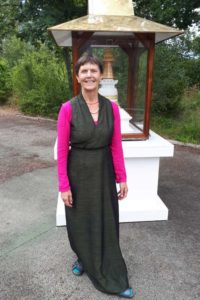
“In May of 2019 I was at Vajra Yogini Institute in France for a lesson from Lama Zopa Rinpoche. While there I met a number of nuns that I’d first met back in 1986, when Lama Zopa gave a lesson at Maitreya Instituut, then located in Maasbommel, the Netherlands. My first contact with the Dharma was in November 1984, when the institute’s first resident teacher, Geshe Konchog Lhundrup, gave me my first spoonful’s of Buddhist teachings over reincarnation.”
“In 1985 I took refuge from His Holiness the Dalai Lama in Rikon, Switzerland. I decided to help then manager, Jan Paul Kool, and the center’s translator Hans van den Bogaert, and began living at the center in Maasbomel. In July of 1987, the center purchased an old youth hostel in Emst, in the Veluwe forest. I could hardly believe it when I saw it, because it was close to where I was born. And I could hardly believe my ears when Jan Paul and Margot told me there was a place for me to live there as well!”
We would cry from laughter from the stories from Geshe Sonam Gyaltsen
“I performed many supporting roles through the years helping to run the center: from household duties to helping Hans van den Bogaert with articles for Maitreya Magazine until it ceased publication in 2006. We had many visiting lamas, like Dagpo Rinpoche, Sangra Jampa Rinpoche, Achog Rinpoche, and Lama Zopa Rinpoche just in 1990 alone! Just after Lama Zopa left that year, I received word that I was accepted in a course for caring for the dying, and would be able to work, study and continue to stay at the center and volunteer there. It felt incredible that I could now work and apply what I was learning at Maitreya. Lama Zopa gave the first European Summer Lam Rim while in Holland that summer. 1990 was very special.”
“I was there when Geshe Sonam Gyaltsen first arrived in July of 1992. He is a very funny man. When Geshe Gyaltsen and the then co-director Thirza Dodd and I would fill statues together, Thirza and I would be crying with laughter from the stories he would tell.”
“I helped out in the ‘Tiener Weekenden’ during this period and worked in our store as well helping Jan Paul. In 1998 I gave up my room so that the Tibetan doctor, Amchi Lobsang, could open a practice at the center, and I helped during those three years as a patient’s assistant.”
I’m always so surprised how a small team can accomplish so much, with joy and harmony
“Since the move to Loenen in 2012, I was assigned a continuing role as a meditation leader for the general public, which I started doing in 1998. I organize the pujas and support the workgroup that works with the dying, which I’ve done since 2006.
I’m always surprised how such a small team can accomplish so much work, and with so much joy and harmony.”
“I’ve seen so many students come and go. Maitreya Instituut is the place that has helped so many other Buddhist organizations get there start, like Dagpo Rinpoche and Kadam Choling, and Gelek Rinpoche and Jewel Heart, who got their starts at Maitreya.”
“In Geshe Sonam Gyaltsen’s book, “A Life Story”, which I helped write and edit, there is a very impressive list of all the lessons he’s given through the nearly 30 years, as well as a list of all the rituals he’s taught us, which he learned from the renowned teacher of His Holiness the Dalai Lama, His Holiness Zong Rinpoche, at a refugee camp in Buxaduar, India. I continue to be inspired by my teachers.”
“I apologize to those I’ve offended … I’ve gotten much milder through the years”
“Finally, I apologize to all the people I may have offended through the years, as I know I can be a bit difficult. Buddhism has really helped me to grow and change, and I’ve gotten much milder through all the years! I still drink the Dharma nectar with joy, and have an increasing understanding of the simple advice of the Buddha, ‘to do no evil, but good, and tame the mind’.
Woman on a Mission: Interview with Brigitte Bol, director, Maitreya Loenen
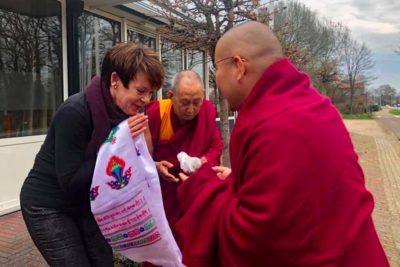
With the move to Loenen in 2012, the center took on a large facility and a large debt as well. Enter, Brigitte Bol, a former HR executive with a quick smile and a keen sense of family and business, whose dedication to her work means living 4 days a week at the center. I spoke with Brigitte in June of 2019 about her experiences so far.
Her ‘home away from home’ is a former wc
I’ve known Brigitte for a few years and have always been impressed with her warm approach to solving problems and her quick smile. I was also impressed that she was willing to give up her comfortable home several days a week to live at the center. I’d heard that she had an ‘apartment’ at the center, and thought this a sensible plan. When we sat down to talk in her office in June, I mentioned the apartment, recalling the rather large, comfortable apartments at the Amsterdam center when it was located on the Brouwersgracht. Brigitte laughed and immediately sprung up and said, “would you like to see it?”
Just around the corner from her office is her ‘home’ away from home. The ‘apartment’ is a small, former toilet, with a mattress on the floor taking up a large portion of the space. I’ll call that dedication, and her humor, I’ll call a useful tool in a Dharma center.
“I began as a volunteer in 2012 after one of the members suggested I might like to help to professionalize the organization in its new location. I was consequential and clear in what was needed for the center, and together with Maarten, we automated the systems.”
We’re one of the largest Buddhists facilites in Europe
“My job was to put the business model to work and to define the new jobs being created. We have 5 meeting halls, 2 dining rooms, 38 guestrooms (most en suite) and 67 beds, so we’re one of the largest Buddhist facilities in Europe.”
What began as a temporary position quickly expanded after she was asked if she could stay on as director.
“I like that Buddhism teaches you that you are responsible for yourself. You are responsible for both the good and the bad things that happen in your life. I can’t compare this center with other centers, but what I hear is that this center is unique. Loenen works with Lama Yeshe’s sustainability model. He said, ‘it’s best to combine some sort of business with a Dharma center because there aren’t so many sponsors in the West.’”
“We mostly have groups of between 25-30 people that rent out the center. Actually, word got around fast and we didn’t have to do much in the way of advertising and PR. We provided good service, good food and everything based on Buddhist principles.”
Peter is such a very good cook … the food is important
As much as the center had benefitted from truly delicious vegetarian meals from professional chef Maarten de Vries, his successor, Peter van Overbeek, appears to have effortlessly taken over the reigns … And then some. To be honest, on my last several visits to the center, I heard as many impassioned discussions about the incredible food as I did about what was being taught. He cooks for all groups attending events at the center.
Brigitte added,
“Peter is such a very good cook. I’m surprised every time that he can accommodate all the dietary wishes of everyone and make something so delicious. I always tell everyone, ‘we can give the best possible, but if the food isn’t good, the service is nothing’. To be sure, it’s a combination also of clean rooms and good service … But the food is important.”
It’s so different from the corporate world … it’s real family
“Lama Zopa has also been very supportive. From the very beginning he immediately just said, “do it!”, when we mentioned all the changes we were planning. When he came in 2015, we had 430 guests for the weekend, and 350 during the week. We had 50 or so volunteers and everything went beautifully.”
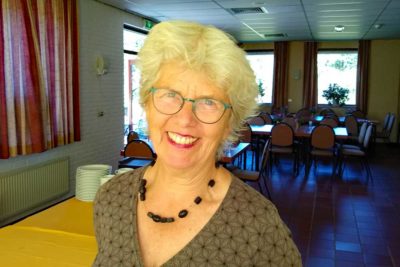
The center also gets a lot of help from Paula Mathijssen, facilities manager, who says her job is to “make sure everything is clean and tidy and cozy.”
“We are a group of colleagues, and we are a sort of family,” Brigitte adds. “Many of the people who work here, live here as well. We’ve got all these external groups as well, and they feel at home too. Everyone is so at home you can’t tell who is who and from which group when these groups visit again; you hug and it’s just so different from the corporate world … It’s real family.”
“It’s really incredible, because Lama Yeshe’s ideas are still alive today!”
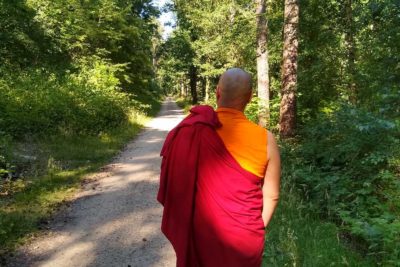
This article is dedicated to Lama Zopa Rinpoche, Geshe Sonam Gyaltsen, and Ven. Kaye Miner, who’ve worked tirelessly to be living examples of the Buddha for the students of Maitreya Instituut over a number of decades. This article is also dedicated to all of the other teachers and the hundreds of volunteers who have given their time, energy and enthusiasm over many years to help keeping the institute’s doors open; inspiring so many people, like myself, to discover the timeless truths of the Buddha.
“I thank you all for giving me a safe place, an inspiring place, a place to really learn and grow. We are all part of a special family. This is so rare and precious in our world today that I wonder if people reading this article believe this is even possible? It is! Believe it or not, there really are altruistically minded people whose only goal is to skillfully guide others to increasing states of happiness and away from their problems and suffering: Maitreya Instituut is one such place.”

